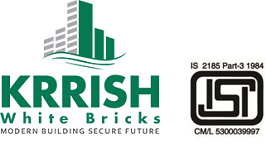Frequently asked questions (FAQ)
No, AAC was invented over 70 years ago in Sweden. Since then, AAC has gained acceptance around the world.
1:6 Cement mortar or 1:3 Krrish Blocks Jointing Adhesive on 2-3mm thick for both vertical and horizontal joins.
Since in AAC products there are 70% to 80% air, depending on the required density, independent testing has shown that k value for AAC is 0.24 W/Mk (max).
Fly ash, Cement, Lime, Gypsum, Aluminium Powder, Water and an expansion agent. The end result is a building material called AAC BLOCKS that is roughly 70% to 80% air in it.
Autoclaved Aerated Concrete is extremely durable. It does not rot or decay like wood or other organic materials. It does not rust like metal. Termites and other pests do not eat it. AAC will not burn. The millions of tiny cells in AAC cushion buildings from major force, preventing progressive collapse.
AAC can be finished with sheet rock (directly attached), plaster (directly applied), tile, non-vinyl wallpaper, paint... again, or any other standard finishing.
AAC blocks are dispatched within 2-3 working days after confirmation of order. There is no seasonal variation in supplies.
Autoclaved Aerated Concrete is extremely durable. It does not rot or decay like wood or other organic materials. It does not rust like metal. Termites and other pests cannot cause damage to it. AAC is not combustible. The millions of tiny pores in AAC cushion the building, preventing progressive collapse.
AAC can be finished with brick, stone, stucco, wood / vinyl siding or any other standard finish, following the recommendation of the architect.
No. AAC was invented over 70 years ago in Sweden. Since then, it has gained acceptance around the world especially in Europe, Middle East, North America, China and now in India.
AAC can be finished with sheet rock (directly attached), plaster (directly applied), tile, non-vinyl wallpaper, paint or any other standard finishing.
The production process of AAC Blocks uses fly ash which is a by-product in thermal power plants. Conventional bricks need fertile top soil. Therefore use of AAC Blocks as an alternative to red bricks prevents needless erosion of fertile top soil. Also, the production process of AAC Blocks is very energy-efficient and emits very less CO2. AAC Blocks used in construction of 15 sqft of carpet area uses 0.9677 kg of coal. AAC Blocks are recyclable. Usage of AAC Blocks significantly reduces electrical expenses due to reduced HVAC (Heating, Ventilation and Air-Conditioning) load, qualifying it to be a "Green" building material.



